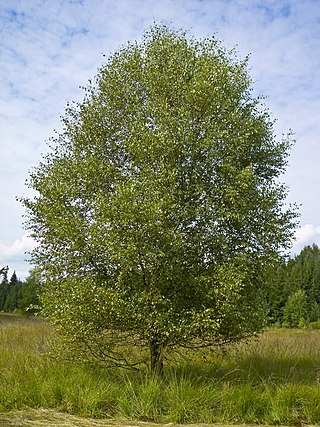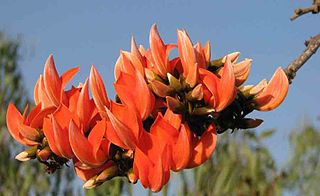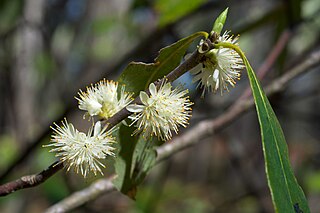
Alnus glutinosa, the common alder, black alder, European alder, European black alder, or just alder, is a species of tree in the family Betulaceae, native to most of Europe, southwest Asia and northern Africa. It thrives in wet locations where its association with the bacterium Frankia alni enables it to grow in poor quality soils. It is a medium-sized, short-lived tree growing to a height of up to 30 metres (98 feet). It has short-stalked rounded leaves and separate male and female flowers in the form of catkins. The small, rounded fruits are cone-like and the seeds are dispersed by wind and water.

Betula pubescens, commonly known as downy birch and also as moor birch, white birch, European white birch or hairy birch, is a species of deciduous tree, native and abundant throughout northern Europe and northern Asia, growing farther north than any other broadleaf tree. It is closely related to, and often confused with, the silver birch, but grows in wetter places with heavier soils and poorer drainage; smaller trees can also be confused with the dwarf birch.

Vitex lucens, or pūriri, is an evergreen tree endemic to New Zealand.

Acacia auriculiformis, commonly known as auri, karuvel in Tamil Nadu and Karnataka and aakashmani in West Bengal, is a fast-growing, crooked, gnarly tree in the family Fabaceae. It is native to Australia, Philippines, Indonesia, and Papua New Guinea. It grows up to 30 metres (98 ft) tall. Acacia auriculiformis has about 47,000 seeds per kilogram (21,000/lb).

Couroupita guianensis, known by a variety of common names including cannonball tree, is a deciduous tree in the flowering plant family Lecythidaceae. It is native to the tropical forests of Central and South America, and it is cultivated in many other tropical areas throughout the world because of its fragrant flowers and large fruits, which are brownish grey. There are potential medicinal uses for many parts of Couroupita guianensis, and the tree has cultural and religious significance in South and Southeast Asia. In Sri Lanka and India, the cannonball tree has been widely misidentified as the Sal tree, after its introduction to the island by the British in 1881, and has been included as a common item in Buddhist temples as a result.

Indigofera tinctoria, also called true indigo, is a species of plant from the bean family that was one of the original sources of indigo dye.

Baptisia australis, commonly known as blue wild indigo or blue false indigo, is a flowering plant in the family Fabaceae (legumes). It is a perennial herb native to much of central and eastern North America and is particularly common in the Midwest, but it has also been introduced well beyond its natural range. Naturally it can be found growing wild at the borders of woods, along streams or in open meadows. It often has difficulty seeding itself in its native areas due to parasitic weevils that enter the seed pods, making the number of viable seeds very low. The plant has low toxicity levels for humans.

Butea monosperma is a species of Butea native to tropical and sub-tropical parts of South Asia and Southeast Asia. It is also known as flame of the forest, dhak, palash, and bastard teak. Revered as sacred by Hindus, it is prized for producing an abundance of vivid blooms, and it is also cultivated elsewhere as an ornamental.

Olea capensis, the black ironwood, is an African tree species in the olive family Oleaceae. It is widespread in sub-Saharan Africa: from the east in Somalia, Ethiopia and Sudan, south to the tip of South Africa, and west to Cameroon, Sierra Leone and the islands of the Gulf of Guinea, as well as Madagascar and the Comoros. It occurs in bush, littoral scrub and evergreen forest.

Etikoppaka is a small village on the banks of Varaha River in Anakapalli district of Andhra Pradesh, India. In 2017, the traditional Etikoppaka toys acquired a geographical indication (GI) tag.

Persicaria tinctoria is a species of flowering plant in the buckwheat family. Common names include Chinese indigo, Japanese indigo and dyer's knotweed. It is native to Eastern Europe and Asia.

Ziziphus nummularia, commonly known as wild jujube or jhahrberi in Hindi, is a species of Ziziphus native to the Thar Desert of western India and southeastern Pakistan, south Iran, Afghanistan, Lebanon and Zimbabwe. Ziziphus nummularia is a shrub up to 6 metres (20 ft) or higher, branching to form a thicket. The leaves are rounded like those of Ziziphus jujuba but differ from those in having a pubescence on the adaxial surface. The plant is commonly found in arid areas, hills, plains, and agricultural fields.

Channapatna toys are a particular form of wooden toys and dolls that are manufactured in the town of Channapatna in the Ramanagara district of Karnataka state, India. This traditional craft is protected as a geographical indication (GI) under the World Trade Organization, administered by the Government of Karnataka. As a result of the popularity of these toys, Channapatna is known as the Gombegala Ooru (toy-town) of Karnataka. Traditionally, the work involved lacquering the wood of the Wrightia tinctoria tree, colloquially called Aale mara (ivory-wood).

Dalbergia sissoo, known commonly as North Indian rosewood or shisham, is a fast-growing, hardy, deciduous rosewood tree native to the Indian subcontinent and southern Iran. D. sissoo is a large, crooked tree with long, leathery leaves and whitish or pink flowers.

Symplocos tinctoria is a deciduous or evergreen shrub or tree. It is recognized by pith of twigs chambered; by foliage not notably aromatic when bruised, leaves finely hairy beneath. Shrubs or trees to 17 m tall by 36 cm diameter at breast height. The largest first-year twigs are under 3 mm across, terminal buds with acute tip, scales ciliate. Leaves are 7–15 cm long, margin entire or occasionally some teeth on the apical half, with a sweet taste that may be faint in old leaves. It is conspicuous when in flower; flowers opening before new leaves develop, fragrant, in clusters from axils of previous year's leaves or from just above the leaf scars if the leaves have fallen; the petals are creamy yellow to yellow, with one pistil. Fruits nearly cylindrical to ellipsoid drupes 8–12 mm long, with thin pulp and a hard stone containing one seed; the tip usually retaining parts of the sepals. Foliage is relished by browsing wildlife. A yellow dye may be obtained from bark and leaves. It flowers March to May.

Maesopsis eminii, the umbrella tree, is a species of tree in the family Rhamnaceae found in India and Africa. It is the only species in the genus Maesopsis. It is often grown as a plantation tree, and as a shade tree in coffee plantations and other crops. Birds and monkeys may disperse the seeds. Since this tree grows fast it is often used for regeneration of destroyed forest lands. Its timber is used for construction and firewood and its leaves for animal fodder.

Lomatia tinctoria, commonly known as guitar plant, is a shrub to about 2 metres tall of the family Proteaceae. It is one of three species of Lomatia endemic to Tasmania, the others being L. polymorpha and L. tasmanica. Lomatia tinctoria is closely related to L. polymorpha, with which it sometimes hybridises. Its leaves are divided, while those of L. polymorpha are simple.

Cola nitida is a species of plant belonging to the family Malvaceae.
Varnam is a social enterprise that has been working with artisans in Channapatna, Karnataka in India, for more than four years. It has produced a series of designs intended to bring this 200-year-old toy-making craft into the home and lifestyle. Using traditional lac-turnery methods popularized by the traditional Channapatna toys range, the label produces home and lifestyle products, toys and jewelry.

Erythrina berteroana is a species of small deciduous tree in the family Fabaceae. It is found in Mexico, Central America and the northern part of South America. Common names include elequeme, gallito, machete, pernila de casa, pito and poró de cerca. It is a common tree in the drier parts of its range and has many traditional uses.

























